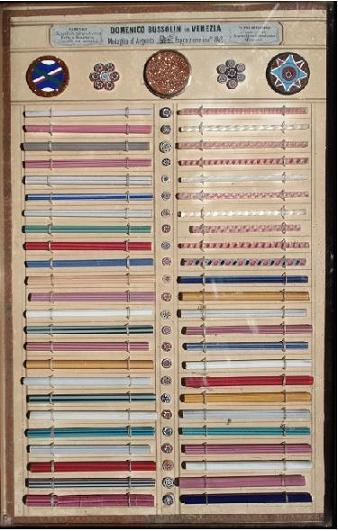Storia del vetro di Murano
Un protagonista della rinascita muranese dell'Ottocento: Domenico BussolinA Protagonist in the Muranese Renaissance of the 19ty Century: Domenico Bussolin

Il Museo del vetro di Murano conserva alcuni pannelli con canne di filigrana (due delle quali con fili di avventurina), canne millefiori, murrine e lavori ad intarsio. Sono intitolati: DOMENICO BUSSOLIN in VENEZIA - Medaglia d'argento Esposizione Industriale 1842. Ciò ha fatto pensare che quei pannelli siano stati composti in quell'anno.
Egli vinse effettivamente quella medaglia, ma continuò ad occuparsi di smalti e conterie ancora per molti anni (tentò anche di aprir fornace in Grecia e (forse) in Slesia) e i pannelli sono stati probabilmente fatti dopo.
Nel 1868 Bussolin presentò canne millefiori fatte in fornace (e non a lume) e forse sono queste canne ad essere contenute nei pannelli.
The Glass Museum of Murano preserves some panels with samples of filigree cane (two of them with coloured and “avventurina” threads) and millefiori canes, “murrine” and inlay work, which relate a writing: DOMENICO BUSSOLIN IN VENEZIA - MEDAGLIA D'ARGENTO ESPOSIZIONE INDUSTRIALE 1842. This makes everybody to believe that those panels have been made in that year.
He really won a silver medal in the Venetian competition of 1842, but he had continued to work for many years enamels and “conterie” (he tried also to open a factory in Greece and (perhaps) in Slesia) and the panels, most likely, are later.
Bussolin in 1968 presented millefiori canes hand made in a glass factory (not at lampwork), and likely the panels in Glass Museum contain those canes.
But it seems that also before the glass-workers Ongaro, who worked by Bigaglia in Venice, realised millefiori canes, trying even to obtain canes with figures.



Paolo Zecchin Via Cappuccina 13 Mestre Venezia
A Protagonist in the Muranese Renaissance of the 19ty Century: Domenico Bussolin
Il Museo del vetro di Murano conserva alcuni pannelli con canne di filigrana (due delle quali con fili di avventurina), canne millefiori, murrine e lavori ad intarsio. Sono intitolati: DOMENICO BUSSOLIN in VENEZIA - Medaglia d'argento Esposizione Industriale 1842. Ciò ha fatto pensare che quei pannelli siano stati composti in quell'anno.
Egli vinse effettivamente quella medaglia, ma continuò ad occuparsi di smalti e conterie ancora per molti anni (tentò anche di aprir fornace in Grecia e (forse) in Slesia) e i pannelli sono stati probabilmente fatti dopo.
Nel 1868 Bussolin presentò canne millefiori fatte in fornace (e non a lume) e forse sono queste canne ad essere contenute nei pannelli.
The Glass Museum of Murano preserves some panels with samples of filigree cane (two of them with coloured and “avventurina” threads) and millefiori canes, “murrine” and inlay work, which relate a writing: DOMENICO BUSSOLIN IN VENEZIA - MEDAGLIA D'ARGENTO ESPOSIZIONE INDUSTRIALE 1842. This makes everybody to believe that those panels have been made in that year.
He really won a silver medal in the Venetian competition of 1842, but he had continued to work for many years enamels and “conterie” (he tried also to open a factory in Greece and (perhaps) in Slesia) and the panels, most likely, are later.
Bussolin in 1968 presented millefiori canes hand made in a glass factory (not at lampwork), and likely the panels in Glass Museum contain those canes.
But it seems that also before the glass-workers Ongaro, who worked by Bigaglia in Venice, realised millefiori canes, trying even to obtain canes with figures.



Paolo Zecchin Via Cappuccina 13 Mestre Venezia
Egli vinse effettivamente quella medaglia, ma continuò ad occuparsi di smalti e conterie ancora per molti anni (tentò anche di aprir fornace in Grecia e (forse) in Slesia) e i pannelli sono stati probabilmente fatti dopo.
Nel 1868 Bussolin presentò canne millefiori fatte in fornace (e non a lume) e forse sono queste canne ad essere contenute nei pannelli.
